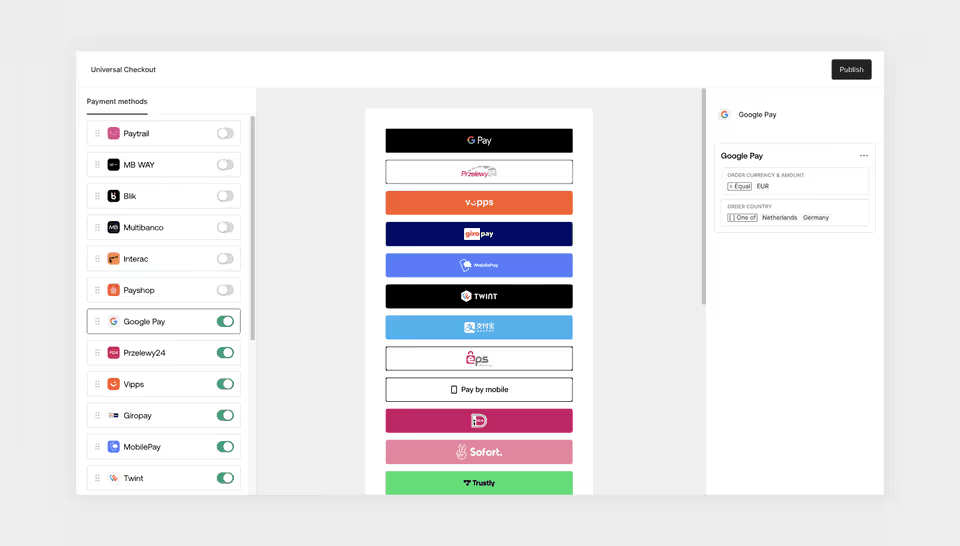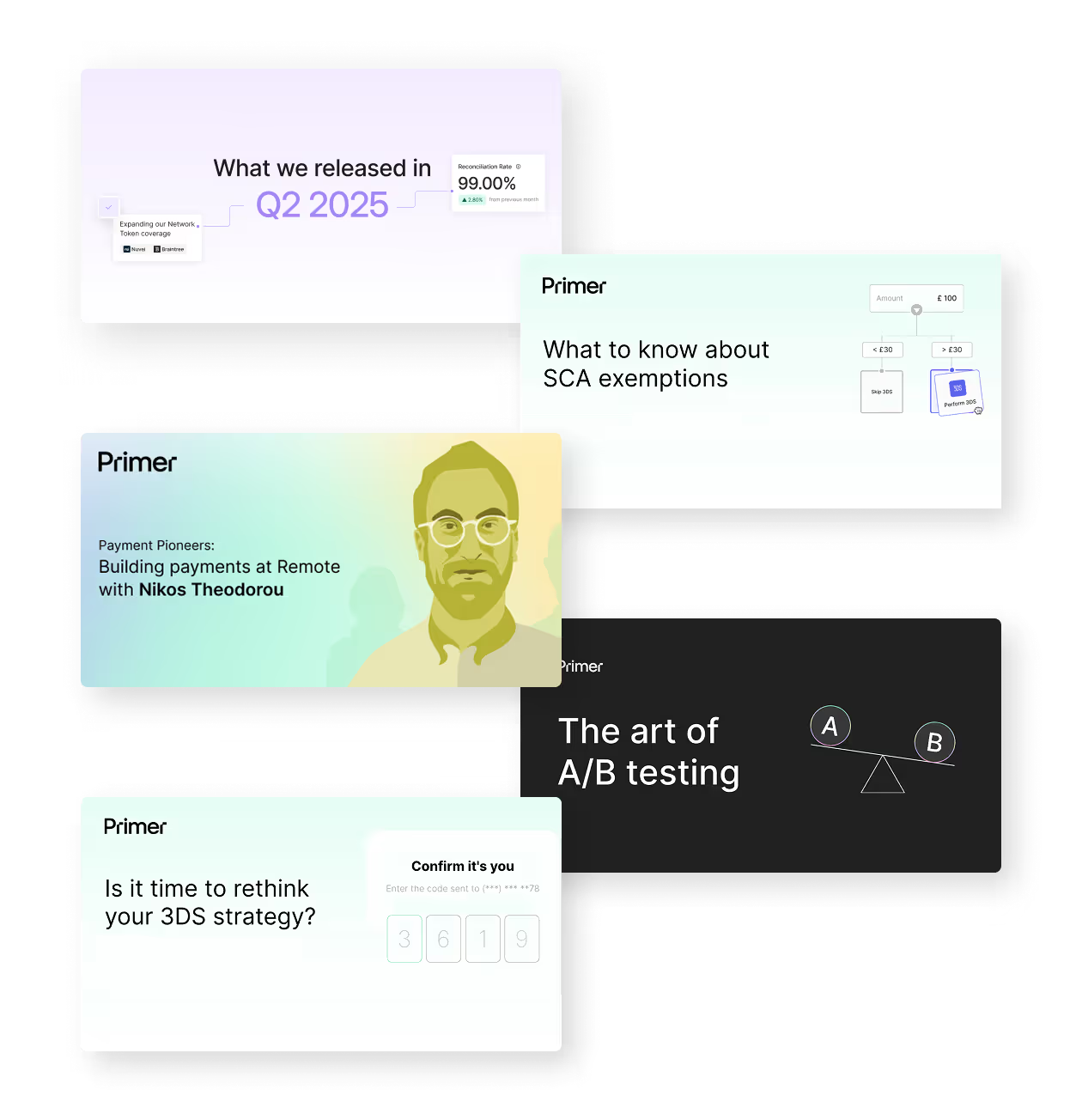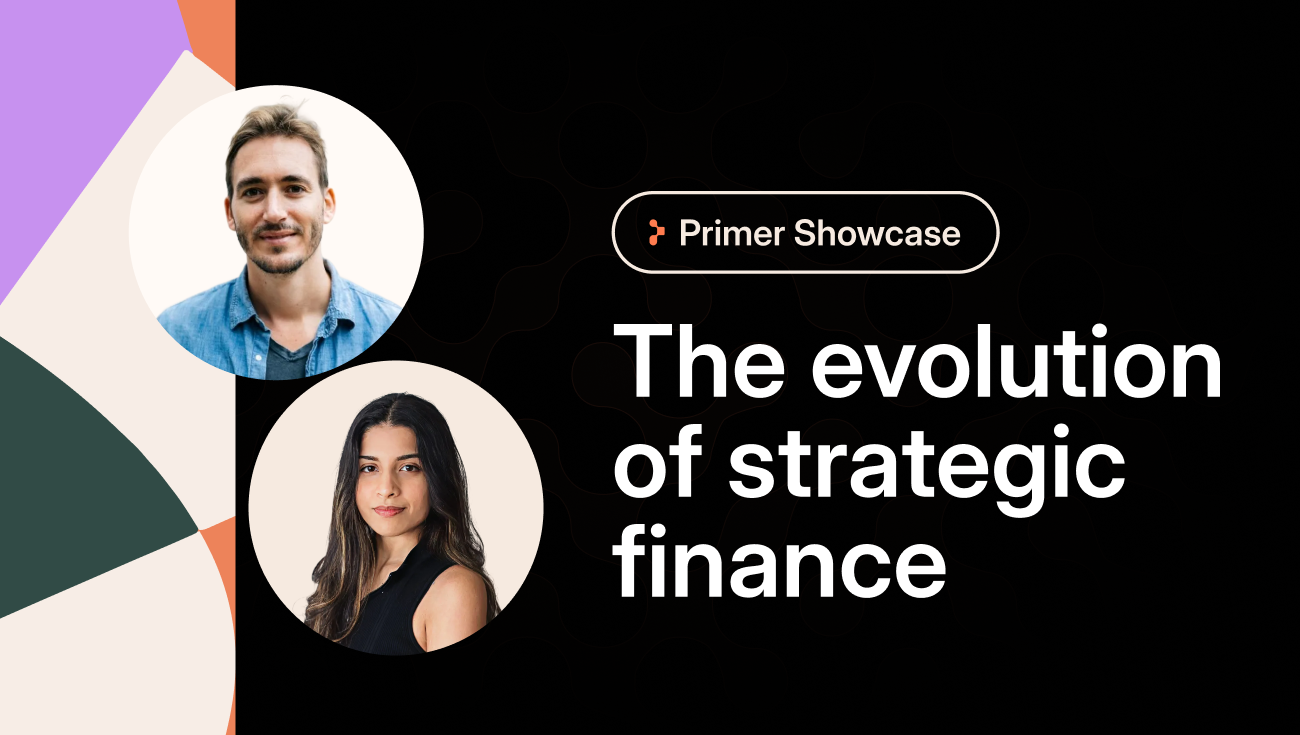Payment optimization wasn't a phrase in most companies' lexicon, let alone an item on their roadmap, until fairly recently. That's changed as consumer purchasing behavior evolved and businesses recognized the importance of payments optimized for cost, performance, and customer experience.
Gone are the days when payments were an afterthought. Now, when done right, they’re a key strategy that can give businesses an edge over competitors.
According to S&P's research, 45% of enterprise merchants have already recognized this opportunity and are actively working on optimizing their payments.
But what exactly does payment optimization mean? How can your business improve its payments? And what should you keep in mind when starting a project to optimize payments? This blog will explain everything.
Want to make the most out of your payments? Book a call with Primer to explore how we can help.
What is payment optimization?
Payment optimization involves improving your payment strategy, technology stack, and processing logic to achieve several crucial objectives:
- reducing cost
- improving authorization rates
- minimizing instances of fraud
- providing a seamless customer experience.
These improvements can range from small changes, like reordering payment methods at checkout, to bigger upgrades, such as adding new payment service processors and setting up dynamic payment routing strategies.
Given the complexity and diversity of the payments ecosystem, numerous options are available as you embark on your payment optimization journey. Success lies in understanding your business objectives and tailoring your optimization strategies to meet those needs.
Four key areas of payment optimization
1. Optimizing for conversion
The core purpose of your checkout page is to encourage customers to complete their payment. Getting this right is both art and science.
It's an art because you must ensure the look and feel of your checkout are on brand. This helps build customer trust and makes shopping easy and enjoyable on any device. If you don’t get this right, customers might abandon their cart and shop elsewhere.
The science comes in when you consider your customers, where they are, and their preferences.
For instance, if you're selling a watch to a customer in Hong Kong, it would be essential to offer a mix of cards and mobile wallets as payment methods and display the price in HKD.
Similarly, when selling a different watch in the Netherlands, it is advisable to offer iDEAL and price the product in EUR.

These examples highlight just a few steps you can take to optimize your payments page. Remember that your customer's behavior is not static; as it evolves, so should your checkout.
Want to know what customers want to see at the checkout? Get our report to find out
2. Optimizing for authentication
In the era of Strong Customer Authentication in Europe and the growing adoption of 3D Secure globally, authentication has become a critical aspect of enhancing the safety and security of online commerce. However, this additional security measure has the potential downside of increased customer friction, leading to cart abandonment.
Optimizing authentication is a balancing act. Merchants must tailor their strategies to their unique risk appetite and business objectives.
Thankfully, merchants have a range of tools to strike this balance effectively. SCA regulations, for example, allow merchants to apply "SCA exemptions," enabling certain payments to bypass 3DS.
Beyond Europe, the latest 3D Secure protocols introduce frictionless authentication. By leveraging additional customer information in the 3DS flow, merchants can identify scenarios where no further customer input is necessary to authenticate a payment.
Learn about how to build a 3DS strategy that meets your business needs.
3. Optimizing for authorization
Now, things get complicated. Just because a customer has pressed pay—and maybe authenticated themselves—it doesn't guarantee the payment will be successful. Maybe your PSP will have an outage. Maybe the issuing bank will flag and stop the transaction. Or perhaps the customer doesn't have the funds in their account to complete the purchase. It's all possible.
While there's no foolproof solution to prevent these issues entirely, there are proactive steps you can take to mitigate their impact. Here are some examples for each scenario:
- PSP outages: A backup processor is critical to safeguarding revenue. This ensures that if your primary processor encounters a problem, transactions can seamlessly switch to the alternate processor automatically using a solution like Fallbacks.
- Issuing bank declines: When an issuing bank declines a transaction due to suspected fraud, you can attempt to recover the payment by asking the customer to authenticate using 3DS. The additional layer of authentication provided by 3DS can reassure the issuing bank and increase the likelihood of transaction approval.
- Declines due to expired cards: Expired cards can be a common reason for payment declines, affecting businesses with recurring revenue models and those that store cards on file for faster checkout. Consider using network tokens if your business faces declined payments due to expired card credentials.
4. Optimizing for cost
Reducing payment costs is a key performance indicator for most payment teams. There are various strategies you can employ to achieve this goal:
- Meeting minimum volume requirements: PSPs often offer discounts to businesses that meet their minimum transaction volume requirements. By reaching and maintaining these thresholds, payment teams can access volume-based pricing, lowering each transaction's cost.
- Fraud and chargeback reduction: Reducing payment fraud and chargebacks is essential for cutting down processing costs, fines, and fees. Strong fraud prevention tools and technologies, such as 3D Secure, can help minimize these risks and result in significant cost savings.
- Streamlining internal processes: Simplify your internal operations using automation tools for tasks like reconciliation. This eases the workload and enhances accuracy and efficiency, resulting in cost savings over time.
While reducing costs is a key priority for merchants, it’s important not to see payments as just a cost center. Leading and innovative businesses understand that payments can be a powerful growth driver. By adopting effective payment strategies, you can unlock financial benefits that go beyond cost savings.
These tips only scratch the surface. Get our playbook for growth mindset merchants for more.
Barriers to payment optimization success
Focusing on even one area of payment optimization can bring significant benefits to your organization. However, certain obstacles may prevent your business from fully achieving these gains.
Little to no access to consistent and reliable data
Starting a payment optimization project requires a solid foundation, beginning with benchmarking your current performance and measuring the impact of any changes. Consistent and reliable data is crucial for this process, but it can be challenging when working with multiple providers, each with different data structures.
Technical debt and resource constraints
Payment optimization often relies on running small tests to achieve gradual improvements. However, this approach can be challenging if your business is constrained by outdated technical architecture, requiring substantial resources for even minor changes. If your organization faces these limitations, it’s essential to address how to increase flexibility in your payment stack before starting any optimization efforts.
Four ways Primer can help you optimize your payment strategy
Primer is a unified payments infrastructure that empowers you to seamlessly connect and manage your entire payments stack and gives you the tools and frameworks you need to optimize payments and unlock new opportunities to achieve your business goals.
As we’ve explored, there are four key areas where you can optimize your payments: conversions, authentication, authorization, and cost.
Here’s how Primer helps you with each one:
Optimizing for conversions: instantly add payment methods with Universal Checkout
Offering customers their preferred payment methods is critical for boosting conversions. Research from the Baymard Institute shows that up to 13% of customers abandon their carts when their preferred payment method isn’t available.
However, manually adding new payment methods requires significant engineering resources for integration and maintenance. It’s common to hear stories of merchants taking months to add a new payment method like Apple Pay to their checkout.
Primer reduces that effort from months to minutes. Once integrated with our Unified API, you have near-instant access to the world’s most popular payment methods and preferred local payment options.
And with our dynamic Universal Checkout solution, you can create a highly tailored checkout experience that meets customer expectations and helps you execute your payment strategy.

With Primer, you can:
- Add region-specific payment methods: Easily integrate local options like iDEAL for the Netherlands or Giropay for Germany to meet customer preferences.
- Customize your checkout interface: Align the checkout design with your brand to build trust and reduce customer hesitation.
- Adapt quickly to market trends: Use Primer’s dashboard to toggle payment methods on or off without developer involvement. For example, during an Apple Pay outage in 2023, Primer customers seamlessly switched to alternatives like PayPal.
- View all your data in one place: Our Observability syncs up with all your payment methods, allowing you to track performance without logging into multiple platforms. Observability gives you over 100 visualizations and over 30 filters to make it simple to make strategic payment decisions based on your data.
Universal Checkout in action
Hellotickets, a global travel platform operating in over 20 countries, faced resource challenges while adding localized payment options.
By using Primer’s Universal Checkout, they:
- Integrated payment methods like Apple Pay in just a few clicks.
- Tailored checkout experiences to match regional preferences and reduced cart abandonment.
- Leveraged consolidated payment data to refine strategies and boost performance.
Read the full case study: Hellotickets opens up the world of payments with Primer
Optimizing for authentication: use Adaptive 3DS to avoid unnecessary friction
Balancing security with customer experience is crucial, as excessive friction during checkout can lead to cart abandonment and lost sales.
But refining your 3DS strategy manually—by setting up custom rules, navigating processor-specific protocols, and ensuring compliance with ever-changing regulations—can be a logistical nightmare.
Primer 3DS makes it simple:
- No-code configuration: Easily set up and manage authentication rules through Primer’s no-code dashboard.
- Processor independence: Decouple authentication from specific payment processors, allowing you to switch providers or optimize workflows without your 3DS strategy changing.
- Regulatory compliance: Ensure your business meets regulatory requirements while maintaining a smooth checkout experience for customers.

Adaptive 3DS in action
Maisons du Monde, a leading home décor retailer in 11 European countries, needed to streamline authentication without compromising security.
By using Primer’s Adaptive 3DS, they:
- Reduced cart abandonment by only prompting authentication when necessary.
- Boosted approval rates with tailored authentication strategies.
- Delivered a smoother, more secure checkout experience.
Read the full case study: Maisons du Monde redesigns its payments with Primer.
Optimizing for increased authorization: set up Fallbacks to reclaim up to 20% of potentially lost revenue
Authorization failures can result in significant revenue loss, whether due to processor outages or declined transactions. However, manually setting up fallback processing is complex and prone to errors, especially when mapping PSP-specific decline codes.
Primer’s Fallbacks automates the rerouting of failed payments, ensuring smooth recovery without requiring manual intervention or advanced technical expertise. With its standardized setup, Primer helps you recover lost revenue and maintain business continuity.
With Fallbacks, you can:
- Recover up to 20% of soft declines: Automatically redirect failed payments to secondary processors.
- Minimize revenue impact during outages: Switch to alternative processors without interruptions.
- Deliver a consistent experience: Reduce churn and maintain customer trust with uninterrupted payments.

Fallbacks in action
Ferryhopper, an online travel agency operating in 12 countries, struggled with failed payments impacting revenue.
By using Primer’s fallback feature, they:
- Automatically rerouted failed payments, recovering 1% of bookings.
- Minimized disruptions during processor outages.
- Improved authorization rates while scaling operations globally.
Read the full case study: Charting a new course for payments at Ferryhopper.
Optimizing for cost: use smart payment routing to choose the most economical processor
Global businesses often face high payment processing fees that reduce their profits. One way to lower these costs is to use an intelligent payment routing strategy.
However, optimizing payment routing can be difficult and time-consuming. It requires constant monitoring and adjustments based on location, transaction size, and processor fees.
Primer Workflows make this easy. With simple tools, you can set up flexible rules to automatically route transactions to the cheapest processors in real-time. This helps save money and improve efficiency—and doesn’t require coding.
Primer's payment routing tool can help you:
- Lower costs: Automatically route transactions to processors with the most favorable pricing structures based on geography, payment type, or transaction value.
- Optimize processor selection: Identify processors with lower fees for specific markets or regions and configure rules to prioritize them.
- Reduce fraud risk: Fraud can be expensive. Primer empowers you to set up routing logic to send certain high-risk transactions through processors with stronger fraud detection capabilities or to prioritize 3DS in specific markets.

Use Primer to optimize your payment strategy
Payment optimization is a priority every business should embrace. It’s not a one-time task; optimization must be an ongoing effort as the payment landscape and consumer preferences evolve.
Businesses should focus on continuous improvements, aiming for small but impactful gains even when larger projects are on hold. Achieving this requires a payments infrastructure like Primer, built with flexibility at its core, enabling businesses to adapt and optimize.
Find out how Primer's commerce infrastructure can deliver that for your business.




(1).png)
.png)